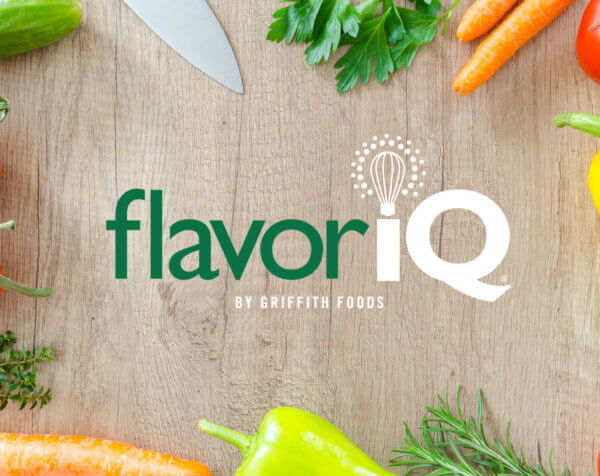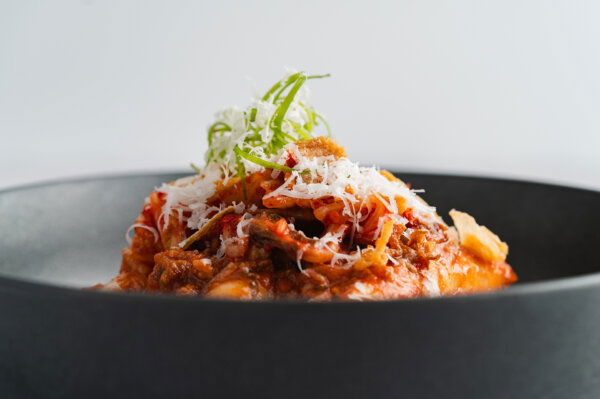Translating trends into business opportunities
Are you ready to learn about the flavors and techniques primed to impact the food industry in the coming year? The Griffith Foods team is proud to share our findings with you. It’s time for our Top 10 Food Industry Trends for 2020.
To kick things off, we’re sharing an overview of our key trends—curated from insights gathered by our team around the world. We hope to inspire you and help you uncover business opportunities as we take a monthly dive into each trend. Each issue of the newsletter will feature chef blogs, product recommendations, recipes, videos and consumer research to support our findings.
PLANT-BASED INDULGENCE
Chefs and manufacturers are proving once and for all that plant-based cuisine can be rich, decadent, and mouthwateringly delicious. In addition to popular plant-based burgers, expect to see inventive meatless and dairy-free versions of fast food and comfort dishes—such as spaghetti and “meatballs,” “chicken” wings, macaroni and “cheese,” poutine with vegan gravy, crispy plant-protein schnitzel and BLTs with mushroom “bacon”—as well as delectable products like cashew-based béchamel sauce, chickpea-battered onion rings and non-dairy frozen desserts made with coconut oil. Vegans, vegetarians, flexitarians, and omnivores alike flock to these items, most of which retain their “better for you” halo even if they’re made with indulgent ingredients.
BETTER WITH AGE
Time-tested food preservation techniques, such as fermenting, pickling, curing and canning, have been used for centuries. Chefs and manufacturers carry on that tradition today to impart bold flavors into food and extend the life of seasonal fruits and vegetables. From fish sauce and kimchi to preserved lemons and pungent black garlic, consumers have shown that they’re open to expanding their palates with the sour, tangy, umami-forward flavors of ingredients that are given time to age and mature. You can introduce these intense flavors to consumers in a fun and accessible way through authentic sauces, seasonings, marinades and more.
THE MAGIC OF MUSHROOMS
What’s not to love about flavorful, functional fungi? In addition to their hearty texture and umami-rich taste, many mushroom varieties are packed with minerals, vitamins and antioxidants. Grocery stores stock mushroom-based wellness teas, coffees and elixirs—often made with less common types such as cordyceps and lion’s mane—that are purported to boost energy and immune function. On the restaurant side, chefs incorporate meaty morel, trumpet, oyster, maitake and cremini mushrooms into creative dishes to offer a punch of earthy flavor or serve as a satisfying substitute for beef or seafood. Mushroom mania has truly become a global phenomenon.
UPCYCLED CUISINE
The term “leftovers” is taking on a new meaning. As the zero-waste food movement gains momentum globally, manufacturers and chefs are innovating like never before to develop delicious “upcycled” products and dishes from what was once overlooked and left behind. Fiber-rich green banana flour derived from less-than-perfect produce, sauces made from beer brewers’ spent grains, coffee flour produced from the pulp of harvested coffee beans and gut-friendly whey beverages made from yogurt and cheese byproducts are just the tip of the iceberg for upcycled cuisine in 2020 and beyond. Get ready to get scrappy!
CRAFTED CONDIMENTS
Artisanal dipping sauces, sandwich spreads and relishes are popping up all over menus and in grocery stores. These creative condiments breathe new life into beloved classics and cater to trend-focused consumers who want to personalize their food with the latest, greatest toppings. They also function as the ideal canvas for chefs and manufacturers to showcase interesting fusion flavors, which, in turn, can inspire consumers to try new-to-them ingredients from globe-spanning regions. From Korean-inspired gochujang aioli, chili-infused honey and mango curry mustard to Indian achaars and ajvar, a red pepper relish popular in the Balkans, premium condiments take dishes from ordinary to unforgettable.
MIDDLE EASTERN EATS
Consumers around the world are discovering—and loving—the craveable flavors of Middle Eastern and North African cuisine as authentic elements of these regions emerge in fast-casual restaurants, grocery stores and beyond. Long-beloved dishes such as hummus, pita bread and shawarma serve as an entry point to the complex and exciting flavors of Levantine and Maghrebi cuisine. Aromatic ingredients, seasonings and spices like za’atar, Aleppo pepper flakes, harissa, sumac, chermoula and rose water add unexpected depth to entrées, desserts, beverages and more. We’ll dive into these tantalizing flavors along with the cooking styles that are propelling Middle Eastern and North African cuisine into the global spotlight.
FIRED UP FLAVOR
Grilled galbi and bulgogi in Korea. Wood-smoked barbecue in the U.S. Slow and low parrilla-grilled steak in Argentina. Tandoor-flamed naan, vegetables, and chicken in India. Coal-fired lamb, corn, and farmer’s sausage at a braai in South Africa. Spin the globe and you’ll find that nearly every country puts its own succulent twist on cooking with smoke and fire. In addition to the sensory delight and primal satisfaction that comes with seeing and smelling flame-cooked food, charring, smoking, searing and grilling inject serious flavor into meat, vegetables, fruits, and anything else that can stand the heat. The right rubs, marinades, and sauces transform these fired-up dishes into craveable classics.
THE MIGHTY LEGUME
It’s time to get better acquainted with the robust and healthy legume family, which includes fiber- and protein-rich beans, chickpeas, lentils, lupins, pulses, and peas. While tried-and-true applications in soups, salads, and hummus are here to stay, imaginative (and special-diet-friendly) new legume uses are emerging in the form of dried snacks, thickening agents for sauces and wheat-free flours. Expect to see more wonder ingredients like aquafaba—the liquid left over after cooking chickpeas—which can serve as a substitute for egg whites and dairy in both savory and sweet applications, from tzatziki and aioli to meringue and frosting.
SWEET BEYOND SUGAR
The world’s collective sweet tooth isn’t going away, but it is evolving and maturing. As food labels become more transparent, consumers are seeking out products and dishes made with less sugar, and they’re becoming more discerning about the source of sweetness. Restaurants and manufacturers can capitalize on the trend toward ditching refined sugar, high-fructose corn syrup and artificial sweeteners by incorporating all-natural alternatives on menus and in products. Ingredients such as pure maple syrup, sorghum, agave nectar, coconut sugar, honey, malted barley extracts and 100% fruit juice add subtle sweetness and depth of flavor while also boasting lower glycemic index values than processed sugars.
BLOSSOMING BOTANICALS
As consumer tastes evolve and become more sophisticated, botanical flavors answer with a one-two punch: They’re both complex in flavor and functional. Plants such as elderflower, hibiscus, wild fennel, turmeric, sage and moringa can coax complex flavors out of the right ingredient pairings, and they may offer a range of health benefits. And while most commonly utilized in beverages—think wholesome tinctures and teas as well as vibrant cocktails and botanical beers—floral notes are sprouting up in desserts and savory dishes, too. We’ll uncover ways to incorporate natural, herbaceous flavors into refined sauces, dressings, coatings and more.

FlavorIQ® enables our customers’ growth and success by approaching the creation of customized solutions with a bold mix of expertise, aspiration and curiosity. We develop unique products, menu concepts and “gold standard” flavor delivery systems, meeting the requirements of our customers today and anticipating their emerging needs, too. The opportunities we identify for operators and food manufacturers on a global scale are rooted in a deep understanding of the culinary arts, sensory science, consumer insights and food science. Our ultimate goal? Innovation without limits.



